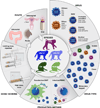Nonhuman primate models for the evaluation of HIV-1 preventive vaccine strategies: model parameter considerations and consequences
- PMID: 27559710
- PMCID: PMC5100008
- DOI: 10.1097/COH.0000000000000311
Nonhuman primate models for the evaluation of HIV-1 preventive vaccine strategies: model parameter considerations and consequences
Abstract
Purpose of review: Nonhuman primate (NHP) models of AIDS are powerful systems for evaluating HIV vaccine approaches in vivo. Authentic features of HIV-1 transmission, dissemination, target cell tropism, and pathogenesis, and aspects of anti-HIV-1 immune responses, can be recapitulated in NHPs provided the appropriate, specific model parameters are considered. Here, we discuss key model parameter options and their implications for HIV-1 vaccine evaluation.
Recent findings: With the availability of several different NHP host species/subspecies, different challenge viruses and challenge stock production methods, and various challenge routes and schemata, multiple NHP models of AIDS exist for HIV vaccine evaluation. The recent development of multiple new challenge viruses, including chimeric simian-human immunodeficiency viruses and simian immunodeficiency virus clones, improved characterization of challenge stocks and production methods, and increased insight into specific challenge parameters have resulted in an increase in the number of available models and a better understanding of the implications of specific study design choices.
Summary: Recent progress and technical developments promise new insights into basic disease mechanisms and improved models for better preclinical evaluation of interventions to prevent HIV transmission.
Conflict of interest statement
None.
Figures

References
-
- Song RJ, Chenine AL, Rasmussen RA, Ruprecht CR, Mirshahidi S, Grisson RD, Xu W, Whitney JB, Goins LM, Ong H, et al. Molecularly cloned SHIV-1157ipd3N4: a highly replication- competent, mucosally transmissible R5 simian-human immunodeficiency virus encoding HIV clade C Env. J Virol. 2006;80:8729–8738. - PMC - PubMed
-
-
Asmal M, Luedemann C, Lavine CL, Mach LV, Balachandran H, Brinkley C, Denny TN, Lewis MG, Anderson H, Pal R, et al. Infection of monkeys by simian-human immunodeficiency viruses with transmitted/founder clade C HIV-1 envelopes. Virology. 2015;475:37–45.. Through the use of pooled virus infections and in vivo virus competition, these authors identify a subset of SHIVs bearing transmitted/founder subtype C HIV-1 Envs capable of mucosal transmission and sustained viremia, though without documented pathogenicity.
-
-
-
Li H, Wang S, Kong R, Ding W, Lee FH, Parker Z, Kim E, Learn GH, Hahn P, Policicchio B, et al. Envelope residue 375 substitutions in simian-human immunodeficiency viruses enhance CD4 binding and replication in rhesus macaques. Proc Natl Acad Sci U S A. 2016;113:E3413–E3422.. Through the introduction of assorted modifications at a site in the HIV-1 gp120 proposed to influence interactions with rhesus CD4, these authors derived replication competent, mucosally-transmissible SHIVs bearing modified Envs from multiple HIV-1 subtypes, suggesting a potential avenue for the generation of “designer” SHIVs bearing specific Envs of interest.
-
Publication types
MeSH terms
Substances
Grants and funding
LinkOut - more resources
Full Text Sources
Other Literature Sources
Medical
Research Materials

